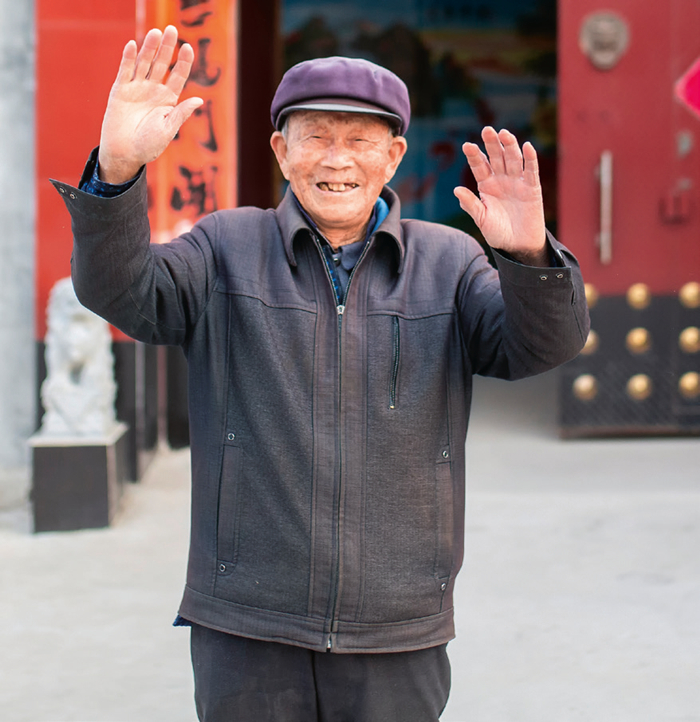|
||||||||||
| Home Nation World Business Opinion Lifestyle ChinAfrica Multimedia Columnists Documents Special Reports |
|
||||||||||
| Home Nation World Business Opinion Lifestyle ChinAfrica Multimedia Columnists Documents Special Reports |
| Current Cover Story |
| Marching Toward Common Prosperity |
| By advancing the vision of common prosperity, China is aiming to achieve more equitable growth, ensuring that benefits of development are shared |
| By LU RUCAI 丨VOL. 14 MARCH 2022 ·2022-03-03 |

Visitors take selfies in a sunflower field in Lanzhou, Gansu Province, on July 31, 2020 (VCG)
The phrase “common prosperity” finds frequent mentions in the government work reports presented by various provincial-level regions in 2022. So, what is the motivation behind China’s pursuit of common prosperity, and what steps should be taken to get there? The notion embodies a long-term vision as well as the Communist Party of China’s (CPC) focus on people- centered development.
Fairer social development
In fact, the concept of common prosperity was formed in the early days of socialist China. The concept was first proposed in the Resolution of the CPC Central Committee on the Development of Agricultural Production Cooperatives in December 1953. Late Chinese leader Deng Xiaoping stressed the importance of common prosperity on several occasions after the reform and opening-up policy was launched in 1978. “The essence of socialism is to liberate and develop the productive force, eliminate exploitation and polarization, and finally achieve common prosperity,” he declared in early 1992, while on an inspection tour in the south of the country.
Recently, greater importance has been attached to common prosperity. President Xi Jinping, who is also General Secretary of the CPC Central Committee, wrote an article in Qiushi magazine titled Making Solid Progress Toward Common Prosperity in October 2021. He said that the CPC has adopted effective measures to improve people’s wellbeing, win the battles to eradicate extreme poverty and build a moderately prosperous society in all respects. “We have thus advanced into a historical stage in which we will make solid steps toward common prosperity.”
According to British scholar Carlos Martinez, China’s strategy of reducing social inequality and encouraging common prosperity is strikingly similar to what some Western progressives are advocating. The strategy, however, will be more effectively implemented in China.
Over the past decade, China expert Shaun Rein, Founder and Managing Director of China Market Research Group, has repeatedly predicted major changes and shifts in the Chinese market. In an interview with a Chinese media, he said, “Many foreigners don’t understand this idea of ‘common prosperity’. In fact, common prosperity is about helping low-income groups; it’s not about trying to destroy capitalism.” He revealed that common prosperity is the theme he pays most attention to today.
“In 2010, I interviewed consumers in many cities in China and at that time, corruption and pollution were their big concerns. Whereas in 2021, when I conducted a new round of surveys, the major problems mentioned were no longer pollution and corruption (because great progress had been made in these two areas). Now, the Chinese are most concerned about housing, education and health. These are precisely the issues that common prosperity is trying to address.”
According to him, the Chinese Government wants everyone to have access to prosperity. The idea is not to make a tenth of the population rich, but to ensure that 90 percent of the people can become rich. This prospect will open up new opportunities for businesses, both in China and around the world, he added.

Image of a panda is shown on a 3D screen in Chengdu on December 9, 2021 (VCG)
Not egalitarianism
On August 17, 2021, Xi presided over the 10th meeting of the Central Committee for Economic and Financial Affairs, which was tasked with examining ways to more effectively promote common prosperity. The meeting clarified what common prosperity is and how to attain it. It pointed out that common prosperity is for everyone, and covers enrichment of people’s lives in both the material and non-material sense. It is not prosperity for a minority, nor is it rigid egalitarianism.
The Chinese Government’s view is that we must not only grow the cake, but also share it properly. With regard to the sharing of the cake in particular, the incomes of the lower classes should be increased and the incomes of the higher classes should be reasonably adjusted, so as to form an olive-shaped wealth distribution structure with a large middle class in the center, and fewer poor and very rich at the ends. Zheng Gongcheng, Professor at Renmin University of China and President of the China Association of Social Security, said, “Common prosperity should be part of a flat society, where everyone can enjoy a good life.” He believes that in order to begin the transition from the current pyramidal society to a flat society, it is imperative to go through this olive-shaped society that has been discussed. Thus, the three-pronged policy (i.e., raising incomes of low-income groups, expanding the middle class, and reasonably adjusting excessive incomes) that was enunciated at the above meeting is the only way forward.
However, it should not be expected that China would exclusively rely on changing its welfare programs and making tax and other modifications to increase the earnings of the poorest households. According to the conference, innovation should be encouraged to provide more opportunities for residents to become affluent and a development environment in which everyone can participate should be fostered. There is a need to adhere to an economic system in which public ownership is the mainstay, with different ownership structures coexisting. It is vital to allow some individuals to become wealthy before others so that those who have achieved success may assist others who have fallen behind.
All of these policies are designed to encourage everyone to participate in the “cake-enlargement” process. On this premise, it is critical to guarantee of people’s livelihoods. For these reasons, Marina Gorbis, Executive Director of the Institute for the Future and a well-known futurist in Silicon Valley, refers to China’s common prosperity goal as a “win-win ideology” that embraces reciprocity and support among individuals.

Tourists take part in Cherry Blossom Festival in a park in Shanghai on March 29, 2021 (VCG)
Mobilization of the whole society
But common prosperity cannot be achieved by the government alone. It calls for the participation of various social sectors.
According to experts, the primary distribution of wealth in China should be mainly carried out through market mechanism. It is necessary to establish a sound mechanism in which the contributions of the factors of production are evaluated by the market, and the remuneration is determined according to one’s contributions. Common prosperity is not equivalent to creating a welfare society. It aims to increase the endogenous strength of the poor so that they can pull themselves out of the clutches of poverty, following the Chinese principle for poverty alleviation that “it is better to teach a person how to fish than to give him a fish.”
The secondary distribution is made through the government’s overall regulatory mechanisms. Like in European countries, the Chinese Government’s wealth redistribution system is implemented through social welfare, public services, pension and regional transfer payments. In recent years, the steady raising of the personal taxable income threshold and the introduction of a progressive tax rate system have reduced the tax burden on low-income groups, while the effects of tax readjustment on high-income groups are increasingly evident. Low-income households receiving social benefits enjoy better guarantees of subsistence, access to medical care and educational opportunities over time. Nevertheless, in the future, China will continue to carry out reform of the tax system, for example, by increasing property taxes and inheritance taxes, with a view to further reduce the income gap.
Finally, there is a third process of wealth redistribution, which encourages social forces to donate privately and fund charitable causes in order to promote common prosperity. This illustrates the notion of allowing some people to become wealthy before others in order for those who have done so to assist others who have not. Indeed, Chinese corporations and high-net-worth individuals have a long history of philanthropy and charitable giving. The “10,000 Enterprises Help 10,000 Villages” and “10,000 Enterprises Revitalize Villages” programs, which are part of China’s poverty alleviation and rural revitalization efforts, involve tens of thousands of businesses.
On August 18, 2021, the day after the 10th meeting of the Central Committee for Economic and Financial Affairs discussed the issue of common prosperity, Chinese Internet giant Tencent announced that after investing 50 billion yuan ($7.89 billion) on the launch of its Sustainable Innovations for Social Value strategy, it would disburse another 50 billion yuan in funds to initiate its Special Project for Common Prosperity. By leveraging its digital and technological capabilities, it will continue to promote rural revitalization, increase the income of low-income groups, improve the basic health system, and pursue balanced development of education, so as to contribute to common prosperity.
After that, Alibaba was quick to announce in September 2021 the launch of 10 major initiatives in support of common prosperity, totaling 100 billion yuan ($15.79 billion) by 2025. In addition, Chinese banks, logistics companies, e-commerce platforms and technology firms, among others, will accelerate innovation and transition in their respective fields. In doing so, they will promote the growth of small and medium-sized businesses while also eradicating gaps between urban and rural areas for the sake of common prosperity.

An old man makes a gesture to bid farewell to 2021 in Binzhou, Shandong Province, on December 31, 2021 (VCG)
While it is too early to assess the efficiency of the policies put in place to promote common prosperity, China has undoubtedly taken a significant step toward more equitable growth.
The general public is supportive of the goal of common prosperity and has confidence in the future. According to the 2022 Edelman Trust Barometer survey report released on January 18, 91 percent of Chinese respondents expressed confidence in their government, and over two-thirds are positive about their country’s economic future. According to Richard Edelman, CEO of Edelman, the growth in China’s public confidence, along with economic assessments, is correlated with increasing predictability in Chinese policies. Edelman noted, “There is coherence between what is done and what is said.”
|
||||||||||||
| About Us | Contact Us | Advertise with Us | Subscribe |
| Copyright Beijing Review All rights reserved 京ICP备08005356号-5 京公网安备110102005860号 |